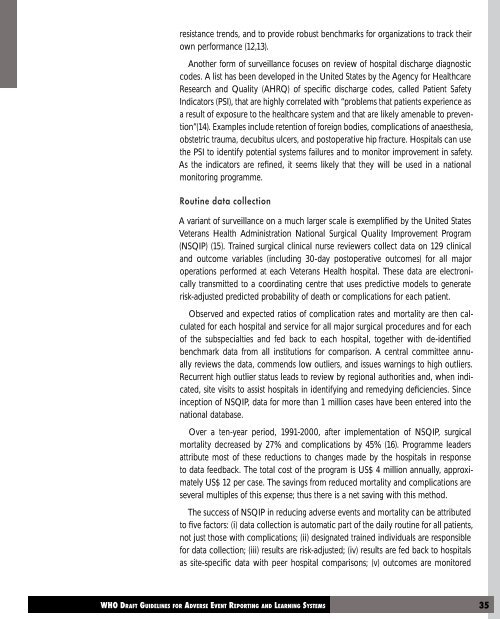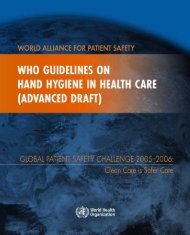Adverse event reporting.pdf
Adverse event reporting.pdf
Adverse event reporting.pdf
Create successful ePaper yourself
Turn your PDF publications into a flip-book with our unique Google optimized e-Paper software.
esistance trends, and to provide robust benchmarks for organizations to track their<br />
own performance (12,13).<br />
Another form of surveillance focuses on review of hospital discharge diagnostic<br />
codes. A list has been developed in the United States by the Agency for Healthcare<br />
Research and Quality (AHRQ) of specific discharge codes, called Patient Safety<br />
Indicators (PSI), that are highly correlated with “problems that patients experience as<br />
a result of exposure to the healthcare system and that are likely amenable to pr<strong>event</strong>ion”(14).<br />
Examples include retention of foreign bodies, complications of anaesthesia,<br />
obstetric trauma, decubitus ulcers, and postoperative hip fracture. Hospitals can use<br />
the PSI to identify potential systems failures and to monitor improvement in safety.<br />
As the indicators are refined, it seems likely that they will be used in a national<br />
monitoring programme.<br />
Routine data collection<br />
A variant of surveillance on a much larger scale is exemplified by the United States<br />
Veterans Health Administration National Surgical Quality Improvement Program<br />
(NSQIP) (15). Trained surgical clinical nurse reviewers collect data on 129 clinical<br />
and outcome variables (including 30-day postoperative outcomes) for all major<br />
operations performed at each Veterans Health hospital. These data are electronically<br />
transmitted to a coordinating centre that uses predictive models to generate<br />
risk-adjusted predicted probability of death or complications for each patient.<br />
Observed and expected ratios of complication rates and mortality are then calculated<br />
for each hospital and service for all major surgical procedures and for each<br />
of the subspecialties and fed back to each hospital, together with de-identified<br />
benchmark data from all institutions for comparison. A central committee annually<br />
reviews the data, commends low outliers, and issues warnings to high outliers.<br />
Recurrent high outlier status leads to review by regional authorities and, when indicated,<br />
site visits to assist hospitals in identifying and remedying deficiencies. Since<br />
inception of NSQIP, data for more than 1 million cases have been entered into the<br />
national database.<br />
Over a ten-year period, 1991-2000, after implementation of NSQIP, surgical<br />
mortality decreased by 27% and complications by 45% (16). Programme leaders<br />
attribute most of these reductions to changes made by the hospitals in response<br />
to data feedback. The total cost of the program is US$ 4 million annually, approximately<br />
US$ 12 per case. The savings from reduced mortality and complications are<br />
several multiples of this expense; thus there is a net saving with this method.<br />
The success of NSQIP in reducing adverse <strong>event</strong>s and mortality can be attributed<br />
to five factors: (i) data collection is automatic part of the daily routine for all patients,<br />
not just those with complications; (ii) designated trained individuals are responsible<br />
for data collection; (iii) results are risk-adjusted; (iv) results are fed back to hospitals<br />
as site-specific data with peer hospital comparisons; (v) outcomes are monitored
















